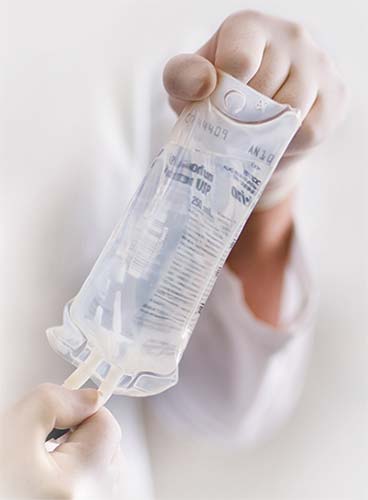IV Sedation in Dentistry
A Proven Way to Enhance Comfort, Prevent Pain & Anxiety
(Continued)
 |
Medications Used for Intravenous (IV) Sedation
Today, the most popular class of medications for IV sedation in the dental office are a class of drugs known as the benzodiazepines, with midazolam (Versed) probably one the most often used. Midazolam acts quickly and wears off faster than some of the older benzodiazepines — Valium (diazepam) and Ativan (lorazepam), for example, which are still used for oral sedation — making it a safer and more useful medication. Midazolam also has a very good amnesic affect. Valium is longer-acting and takes longer for its effect to wear off. It is also more irritating to the veins than is midazolam. Lorazepam has the benefit of being able to be used in some people who cannot tolerate midazolam or valium. Because midazolam and Valium are metabolized by liver enzymes, individuals with compromised liver function or who are taking other medications that interfere with liver function should not use them. Lorazapam is metabolized in the bloodstream and not the liver.
Another medication that is used for sedation and deeper levels of anesthesia is propofol. Propofol is not generally used in dental offices but more often in a hospital setting for dental care. Propofol is very fast acting and has a very short half-life (wears off very quickly); it requires careful monitoring and specialized equipment that automatically delivers timed incremental doses after the anesthesia machine is programed for the particular person.
Frequently, some type of opioid analgesic or pain-reducing medication, such as fentanyl, is added to the IV sedative medication. These medications also contribute to the sedative effect, reducing the need for larger amounts of the other sedation medications. They also help with pain control during dental procedures and with pain relief after the procedures are completed. Nubain (nalbuphine) is another opioid analgesic that some dentists prefer to Fentanyl. Toradol (ketarolac) is a non-steroidal anti-inflammatory and analgesic (non-opioid) that is used in place of the narcotic analgesics since it does not cause respiratory depression that can be seen with the opioid-analgesics.
Sometimes, other medications may be administered to treat possible side effects of sedation, such as nausea or allergy. It is also not unusual for nitrous oxide (also incorrectly known as “laughing gas”) to be used in the beginning of the appointment, to reduce the anxiety of getting the IV started. People who have significant dental fears often are afraid of needles, and the use of nitrous oxide, an anxiolytic (anxiety reducing) gas, can help them get past that part of the sedation procedure.
Before, During And After IV Sedation
Prior to having dental care performed with IV sedation, you will have a comprehensive dental exam, including a thorough review of your medical history. If necessary, the dentist will consult with your physician to make sure you are a candidate for IV sedation in the dental office.
Before IV sedation you should:
- Be accompanied to and from the appointment.
- Not eat or drink after midnight the day before.
- If you need to take prescription medication, speak to both your physician and dentist.
- Wear loose, comfortable clothing to the appointment.
- Don’t wear contact lenses, oral appliances (dentures, retainers, etc.), or watches/jewelry.
During sedation, you will be closely and continuously monitored by the dentist and staff members, using electronic equipment that shows blood pressure, heart rate, the amount of oxygen in the blood and, often, your heart function on an EKG monitor. After the procedure is over, you will not be released until it is safe for you to go home. You and the person taking you home will receive post-treatment and home care instructions including what you should eat and drink. It is usually okay to resume eating and drinking after getting home from the dental appointment, provided the numbness from the local anesthesia has worn off. Drinking lots of water is important after sedation since you will have been without food or water for several hours and may be dehydrated. If there is any soreness, especially after surgery where teeth need to settle down or tissues need to heal, keep off the affected area/s until they feel comfortable. A soft, healthy diet that doesn’t require chewing will be best; try milk shakes or protein/nutrition drinks, for example.
Lastly if pain medication is necessary it is usually best to use over-the-counter non-narcotic medications such as Tylenol, aspirin or Ibuprofen, or prescription-strength medication such as Naproxen or Celebrex if your dentist thinks it is appropriate. Medications like codeine or hydrocodone that will deepen the lingering sedative effects are not advised, especially the day of IV sedation.
Safety First
Safety is paramount for providers of IV sedation. All dentists who offer it must complete programs that meet or exceed the guidelines established by the American Dental Association in 2007. These include extensive training courses in sedation of patients under expert supervision until proficiency, competency and experience are achieved. Training also includes emergency management, such as Advanced Cardiac Life Support (ACLS). At the end of the training programs, dental professionals must pass a comprehensive exam and apply for an IV sedation permit from their state boards of dentistry. To maintain a sedation permit, dentists must also complete additional hours of continuing education and emergency training on a regular basis.
Modern IV sedation can help many people receive dental care in a safe environment — especially those who would not otherwise be able to have treatment due to anxiety, fear or a specific dental phobia. And, perhaps best of all, it generally leaves one comfortable, rested, and with little or no memory of the procedure itself.

